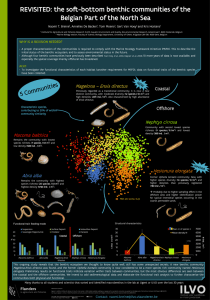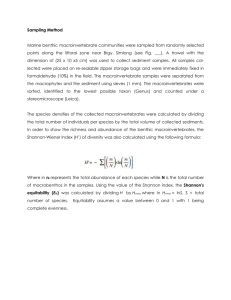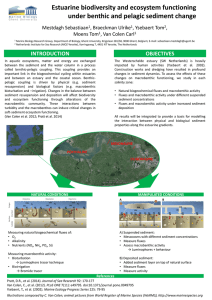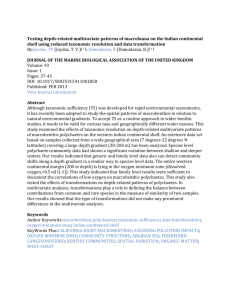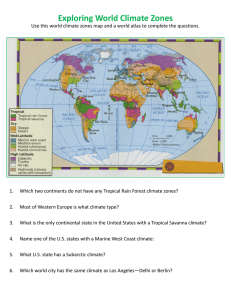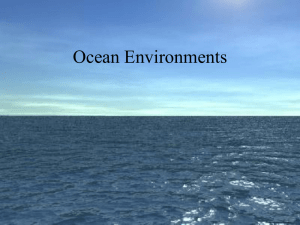9 CHAPTER
advertisement
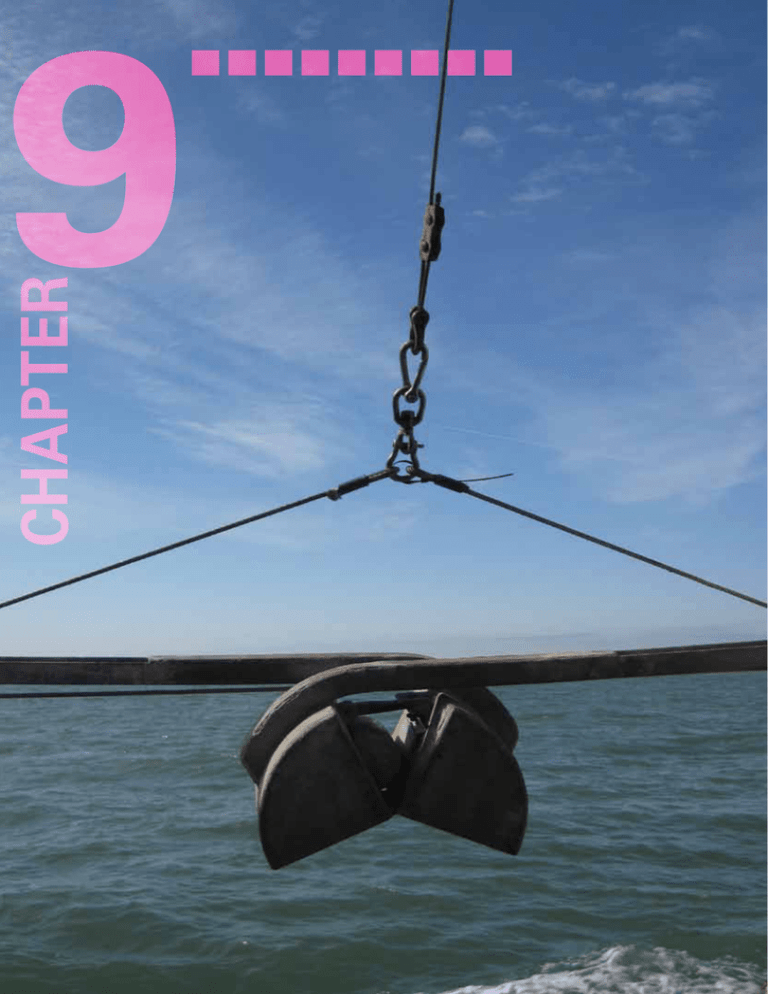
CHAPTER 9 87 The macrobenthic community around an offshore wind farm Delphine Coates, Gert Van Hoey, Jan Reubens, Sarah Vanden Eede, Veronique De Maersschalck, Magda Vincx and Jan Vanaverbeke The soft-substrate macrobenthic community was investigated at a large scale before and after construction of an offshore wind farm. To make a distinction between natural fluctuations of the macrobenthic community and construction effects of the wind farm on the macrobenthos a temporal study was carried out over 32 years followed by a detailed analysis of the monitoring data (2005-2012). A significant difference in community composition was observed between the macrobenthos of the Thorntonbank and the macrobenthic community in the control area during and just after construction, suggesting a short-term construction effect. An impact evaluation with monitoring data was also carried out using the benthic indicator BEQI. INTRODUCTION The soft-substrate macrobenthos (fauna larger than 1mm living in the seabed) constitute an essential link in the trophic organisation of the marine ecosystem. By being an important food source for many organisms such as demersal fish, changes within the macrobenthos could modify crucial relationships within the marine food web. Macrobenthic communities provide an ideal component for evaluating the ecological effects of offshore wind farms on the marine environment as they are mainly determined by the sedimentological and hydrodynamic characteristics of the seabed (Hiscock et al., 2004; Kunitzer et al., 1992) and therefore relatively stable in space and time. However, these communities are influenced by many natural and human induced factors such as commercial fishing, sand extraction, eutrophication and climate variability (Hiscock et al., 2004; Jennings et al., 2001; Kroncke et al., 2011). Therefore, it is essential to place monitoring data within a wider time frame and identify the long-term natural fluctuations of the occurring macrobenthic communities on the Thorntonbank and Gootebank (Van Hoey et al., 2007b). Scientists, managers, and the industry often collaborate in order to gain knowledge concerning the effects, when implementing a certain activity, on the ecological, physico-chemical and socioeconomic status of the ecosystem. To unravel the detailed patterns and causeeffect relationships of the construction of offshore wind farms, a thorough analysis of the monitoring data is carried out in this study. However, in the light of the environmental impact assessment (EIA) processes and management advice, it is necessary to have tools that provide a quick signal of the occurring changes and an alarm when an unwanted situation is reached. Therefore, indicator tools (such as BEQI, Benthic Ecosystem Quality Index [www.beqi.eu]), accompanied by threshold levels, were developed to assess the degree of impact of anthropogenic activities (Van Hoey et al., 2011). The construction and exploitation of offshore wind farms have two direct effects on the soft sediment macrobenthos, firstly through a direct loss of its natural habitat. For example, a loss of 0.11km² seabed was predicted for the offshore wind farm on the Thorntonbank (Ecolas, 2003). Secondly, the introduction of hard substrates in a sandy area attracts different organisms, those colonizing the foundations and those that are associated with the structures, affecting the surrounding soft substrate communities by predation or organic enrichment (Coates et al., 2012; Kerckhof et al., 2009; Krone et al., 2013a; Wilhelmsson and Malm, 2008). Anticipated secondary effects of offshore wind farms during construction (dredging activities or turbidity changes) and during the operational phase (fisheries exclusion and hydrodynamic changes), could produce an essential effect over a longer time scale. The most common commercial fishing method in Belgian waters is beam trawling, disturbing over 80% of the seabed in the Belgian Part 88 D. Coates, G. Van Hoey, J. Reubens, S. Vanden Eede, V. De Maersschalck, M. Vincx and J. Vanaverbeke of the North Sea (Ecolas, 2003).The exclusion of all fishery activities within the wind farm concession areas will lead to a decrease of fishery intensity (Lindeboom et al., 2011), but a possible increase of trawling along the outside border due to a displacement of fishing efforts (see chapter 8). The key objectives of this chapter: 1. Investigating the long-term fluctuations, by a temporal analysis of the macrobenthic communities on the Thorntonbank and Gootebank. This was carried out over a period of 32 years by incorporating historical data from 1980-1998 (Marine Biology Research Group UGent and ILVO-Bioenvironmental Research group) with the monitoring data from 2005-2012. 2. Carrying out a more detailed analysis of the 2005-2012 timeframe by distinguishing different zones (eastern and western impact, control and edge zones) within the Thorntonbank and Gootebank. 3. Applying the benthic indicator BEQI (Benthic Ecosystem Quality Index) to evaluate possible changes in the characteristics (density, species composition and number of species) of the soft substrate benthic ecosystem within and around the Thorntonbank wind farm during and after construction (Van Hoey et al., 2007a). Sampling and assessment strategy Benthic monitoring Within the framework of the wind farm monitoring programme, sediment and macrobenthic communities were sampled with a Van Veen grab (0.1026m²) on the Thorntonbank and Gootebank between 2005 and 2012, during autumn (Figure 1). Both sandbanks are mainly characterised by coarse, sandy sediments (De Maersschalck et al., 2006) with a water depth around 20 meters. A BACI (Before After Control Impact) sampling design (Smith et al., 1993) was applied (see chapter 10 for further details) with the baseline (Year0) monitoring carried out in 2005. The construction of six gravity based foundations was finalised in 2008. Installation of 48 jacket structures was carried out during 2011 and 2012, prohibiting sampling in 2011 and limiting sampling to the control and edge areas on the Thorntonbank in 2012. Therefore, no impact samples are available for 2011 and 2012 (Table 1). The following macrobenthic samples were available from the Thorntonbank and Gootebank area: • Historical data of stations (one to six stations according to the year) sampled in 1980, 1985, 1986 and 1998 (three replicates per station). • T0 monitoring in 2005 (one replicate per station) in five different zones: Gootebank control (GC), Thorntonbank control (TC), edge (TE), eastern impact (TI E) and western impact zone (TI W). • T1 (2008), T2 (2009), T3 (2010), T5 (2012) monitoring during and after construction in the Thorntonbank wind farm, with one or three replicates (from 2010 onwards) per station. When analysing data over longer time periods it is essential to use a uniform dataset throughout the years. At every sampling event, the first replica was selected for every station (except for BEQI analyses, see later) for analysing the changes in macrobenthic communities over longer periods and within the monitoring programme. Table 1. Schematic representation of the different phases of the Thorntonbank wind farm and the macrobenthic monitoring data on the Gootebank (GC), Thorntonbank control (TC), Edge (TE), eastern impact (TI E) and western impact zone (TI W). GBF = Gravity Based Foundation Thorntonbank soft benthic windfarm monitoring data 2005 (T0) Baseline monitoring GC – TC – TE – TI E – TI W 2008 (T1) Construction Phase I (6 GBF at TI W) GC – TC – TE – TI E – TI W 2009 (T2) 2010 (T3) 2011 (T4) 2012 (T5) Operational Phase I Operational Phase I Construction Phases II & III Construction & Operational Phases I - III GC – TC – TE – TI E – TI W GC – TC – TE – TI E – TI W No monitoring data GC – TC – TE The macrobenthic community around an offshore wind farm • CHAPTER 9 • Legend TE Belgian continental shelf Thorntonbank Area reserved for electricity production C-Power Wind farm Monitoring stations TE Historic stations (1980 - 1998) TC (edge) Thorntonbank impact E North Sea depth 0 0-2 meters Thorntonbank impact W TC (top) 51°30'N 2-5 meters 5-10 meters 10-20 meters 20-30 meters Gootebank 30-40 meters land GC (top) GC (edge) 0 2°50'E 2,5 5 Kilometers 3°0'E Figure 1. Large scale monitoring on the Thorntonbank with impact zones TI E (eastern), TI W (western), edge (TE) and control (TC). The Gootebank was sampled as a reference Assessment strategy BEQI The benthic indicator, BEQI (Benthic Ecosystem Quality Index, www.beqi.eu), evaluates the difference in macrobenthic characteristics (density, biomass, number of species and species composition) between two datasets (e.g. control versus impact). The outcome is scaled between 0 and 1 into 5 classes (bad [<0.2], poor [0.2-0.4], moderate [0.4-0.6], good [0.6-0.8], high [0.8-1]). When the BEQI value reaches a value below 0.6 (boundary between moderate and good), we judge that the difference between the two datasets (control – impact) is unwanted and a closer look to the result is advised. In order to execute a proper indicator assessment of a possible impact, it is important to take the natural variability in habitat characteristics, the statistical power and the selection of the control data into account (Van Hoey et al., 2010). An important aspect in assessing the differences in benthic characteristics between areas is that they do not deviate naturally, due to differences in habitat characteristics (such as sediment type, depth, etc…). Therefore, different areas within the assessment design were recognised: The top of the eastern and western impact zones (concession area [TI W and TI E]), the edge of the eastern and western impact zone (the border of the concession zone [TIE W and TIE E]), a Thornton control zone ([TC], top/edge) and the Gootebank control zone ([GC], top/edge). Possible influences on the assessment outcome due to a difference in macrobenthic habitat type are minimised in this way. For an indicator assessment, statistical power i.e. a sufficient number of samples within each pair-wise analysis (controlimpact) is important for a confident assessment (Van Hoey et al., 2010). The assessment designs were therefore based on all data (three replicates per station) within each zone/period (see sampling strategy). To have sufficient control data, the data from the Thorntonbank and Gootebank control zones were analysed together. The BEQI tool assigns the confidence of the assessment based on the variability within the data into three classes: good, moderate and poor. In this study, the confidence of the assessment results are coded into following categories (Table 7): (1) the amount of impact samples are much higher (more than 3 samples) than the amount of control samples (grey), (2) two of the three analysed parameters show a moderate confidence score (cursive), (3) one of the three analysed parameters show a moderate confidence score (bold), (4) all parameters show a good confidence score (red). 89 D. Coates, G. Van Hoey, J. Reubens, S. Vanden Eede, V. De Maersschalck, M. Vincx and J. Vanaverbeke 2. The benthic characteristics of the different areas (top, edge) within the two separate Thorntonbank impact zones are compared with the benthic characteristics in the respective areas (top, edge) in the control zones (Thornton and Gootebank). a. Within each year b. Over time: control data from before 2005 and control data from 2005 (T0) Finally, an appropriate selection of the control data is advised, because different types of control data will have an influence on the final indicator judgement (Van Hoey et al., 2013). To prove this, we used different assessment designs: 1. The benthic characteristics within the Thorntonbank impact zone (no separation between eastern and western and top and edge) are compared with the benthic characteristics in the control area (Thornton and Gootebank): a. Within each year b. Over time: control data from before 2005 and control data from 2005 (T0). Long- term fluctuations Over a period of 32 years, the long term data of the softsubstrate macrobenthos show a clear inter-annual variability in average macrofaunal abundance on the Thorntonbank and Gootebank. Densities on the Thorntonbank reached a peak of 682 ind.m-2 in 1986 while the Gootebank densities showed a maximum in 2008 (812 ind.m-2). Minimum values were measured for both sandbanks in 1998 with 180 ind.m-2 on the Thorntonbank and 244 ind.m-2 on the Gootebank (Figure 2, upper panel), illustrating a likely effect of the extremely cold winter temperatures and negative North Atlantic Oscillation index in 1995/1996 (Neumann et al., 2009; Reiss et al., 2006). In the baseline year of the wind farm monitoring (2005), the macrofaunal abundance was similar on both sandbanks. From 2008 onwards, the macrofaunal densities on the Gootebank showed a higher inter-annual variability in comparison to the Thorntonbank. The average number of species per sample followed the same trend with a minimum average in 1998 of six macrofaunal species per sample on the Thorntonbank and eight on the Gootebank (Figure 2, lower panel). From 2008 onwards, the inter-annual variability of the number of species with a range from 9 to 10 species on the Thorntonbank was fairly stable. In comparison to the Thorntonbank, the Gootebank illustrated an inter-annual variability with peaks in 2008 and 2010. Figure 2. Upper panel: Average total macrobenthic abundance (ind.m-2) ± standard error and lower panel: Average total number of macrobenthic species per sample ± standard error for the Thorntonbank and Gootebank from 1980 to 2012 1200 Total abundance (ind.m-2) 1050 900 750 600 450 300 Gootebank 150 Thorntonbank 2013 2012 2011 2010 2009 2008 2007 2006 2005 2004 1999 1998 1997 1986 1985 1984 1983 1982 1981 1980 1979 0 20 18 16 14 12 10 8 6 4 Gootebank 2 Thorntonbank 2013 2012 2011 2010 2009 2008 2007 2006 2005 2004 1999 1998 1997 1987 1986 1985 1984 1983 1982 1981 1980 0 1979 Number of species per sample 90 The macrobenthic community around an offshore wind farm • CHAPTER 9 • brevicornis (Figure 3). The dominant species on the Gootebank showed a greater inter-annual variability over the 32 years. A clear community shift occurred during the construction year in 2008 with the dominance of the opportunistic S. bombyx on both sandbanks. However, the dominance disappeared from 2009 onwards. The typical macrobenthic (Nephtys cirrosa) community on the Thorntonbank and Gootebank are only dominated by a few species (Table 2). Dominant species were defined as species with a mean contribution of more than 15% to the mean total density. In the time period between 1980 and 1986 the macrofaunal community on the Thorntonbank was mainly dominated by the white catworm Nephtys cirrosa and the mysid shrimp Gastrosaccus spinifer. From 1998 onwards, three species had a re-occurrence in dominance: the polychaete worms: white catworm (N. cirrosa) and bee spionid (Spiophanes bombyx) together with the amphipod Urothoe Table 2. Dominant species and their mean contribution to the mean total density in terms of percentage for the Thorntonbank and Gootebank from 1980 to 2012 Dominant species % Thorntonbank 1980 1985 1986 1998 2005 2008 2009 2010 2012 Gootebank Nephtys cirrosa 20 Bathyporeia elegans 22 Gastrosaccus spinifer 19 Nephtys cirrosa 13 Oligochaeta sp. 16 Gastrosaccus spinifer 36 Scoloplos armiger 13 Bathyporeia elegans 27 Ophelia borealis 21 Nephtys juvenile 19 Nephtys cirrosa 49 Nephtys juvenile 24 Gastrosaccus spinifer 20 Nephtys cirrosa 33 Urothoe brevicornis 25 Urothoe brevicornis 28 Nephtys cirrosa 25 Nephtys cirrosa 28 Spiophanes bombyx 38 Spiophanes bombyx 18 Nephtys cirrosa 39 Nephtys cirrosa 28 Nephtys cirrosa 28 Nephtys cirrosa 13 Spio sp. 12 Urothoe brevicornis 18 Nephtys juvenile 14 Nephtys cirrosa 15 Ophelia borealis 10 Figure 3. The three most dominant species on the Thorntonbank and Gootebank White catworm Nephtys cirrosa Bee spionid Spiophanes bombyx Urothoe brevicornis 91 92 D. Coates, G. Van Hoey, J. Reubens, S. Vanden Eede, V. De Maersschalck, M. Vincx and J. Vanaverbeke When analysing the macrobenthic community composition between the Thorntonbank and Gootebank, a significant difference was measured from 2008 until 2010 (Table 3). The baseline situation in 2005 and all years before did not show any significant differences in community composition between the two sandbanks. In addition, the samples taken in 2012 revealed a possible evolution back to more comparable macrobenthic communities on both sandbanks. However, it should be taken into account that the impact samples within the Thorntonbank wind farm were missing in 2012. 1980 1985 1986 1998 Table 3. Differences in macrobenthic community composition between the Thorntonbank (TB) and Gootebank (GB) from 1980 to 2012. Statistically significant differences (p<0.05) in red and non-significant (p>0.05) in green (PERMANOVA) 2005 2008 TB vs. GB 2009 2010 2012 Wind farm monitoring from 2005 to 2012 To evaluate the differences measured in community composition between macrobenthic communities on the Thorntonbank and Gootebank in 2008, 2009 and 2010 (Table 3), a more in depth analysis was carried out by incorporating the different wind farm monitoring zones. There was a significant difference in macrofaunal community composition between zones from 2005 to 2009. The communities on the western impact zone (TI W), where the first six gravity based foundations were installed, only showed a significant difference with the control zones (GC and TC) and the edge zone (TE) in the construction year (2008) (Table 4). A recovery of the communities at TI W was visible in 2009 as differences were no longer significant, analogous to the baseline year in 2005. Analysis of the macrofaunal community composition based on biomass showed exactly the same results as shown in Table 4 with significant differences between TI W and GC, TC, TE in 2008. Macrobenthic communities on the eastern impact zone (TI E) showed significant differences with GC and TC in 2005 and with GC and TE in 2008 and 2009. As no construction activities were carried out in the eastern zone during this period the differences are illustrating the natural inter-annual variability in community composition between the different zones coinciding with the results in median grain size and total organic matter content (see further). From 2010 onwards no significant differences in community composition were detected (for both density and biomass) between the impact and control zones. Table 4. Differences in macrobenthic community composition between Gootebank control (GC), Thorntonbank control (TC), edge (TE), eastern Impact (TI E), western Impact (TI W) zones from 2005 to 2012. Pairwise comparisons (PERMANOVA), with statistically significant differences (p<0.05) in red and non-significant (p>0.05) in green 2005 2008 2009 TI E TI W GC TC TE GC TC TE GC TC TE Turbines with gravity based foundations on the Thortonbank. • CHAPTER 9 • The macrobenthic community around an offshore wind farm Dominant species showed a large inter-annual variability. In 2005, the macrofaunal communities of all zones were dominated by the white catworm N. cirrosa and the amphipod U. brevicornis (Table 5). The dominant species showed a change in 2008 with an increase of the bee spionid S. bombyx, possibly due to the high sand extraction activities in the area. In comparison to the control and edge zones, N.cirrosa showed a higher dominance (with a mean contribution of 39%) in the western Impact zone. 2005 GC TC TE TI E TI W 2008 Table 5. Dominant species and their mean contribution to the mean total density in terms of percentage for the Gootebank control (GC), Thorntonbank control (TC), edge (TE), eastern Impact (TI E), western Impact (TI W) zones from 2005 to 2012 2009 2010 2012 Species % Species % Species % Species % Urothoe brevicornis 25 Spiophanes bombyx 38 Nephtys cirrosa 28 Nephtys cirrosa 13 Nephtys juvenile 14 Nephtys cirrosa 25 Spio sp. 12 Ophelia borealis 10 Urothoe brevicornis 37 Nephtys cirrosa 27 Nephtys cirrosa 34 Nephtys cirrosa 22 Urothoe brevicornis 25 Nephtys cirrosa 27 Spiophanes bombyx 17 Spiophanes bombyx 15 Thia scutellata 17 Nephtys cirrosa 13 Nephtys cirrosa 30 Nephtys cirrosa 16 Nephtys cirrosa 32 Nephtys cirrosa 29 Nephtys cirrosa 16 Urothoe brevicornis 28 Spiophanes bombyx 16 Urothoe brevicornis 15 Nephtys cirrosa 41 Nephtys cirrosa 32 Nephtys cirrosa 49 Nephtys cirrosa 29 Urothoe brevicornis 20 Spiophanes bombyx 21 Nephtys cirrosa 32 Nephtys cirrosa 39 Nephtys cirrosa 42 Nephtys cirrosa 27 Urothoe brevicornis 30 Spiophanes bombyx 20 Urothoe brevicornis 19 In 2008 and 2009, the western Impact zone on the Thorntonbank showed the lowest average number of species (6.7 ± 1.7 and 8.6 ± 0.8 respectively) in comparison to the other zones (Table 6). The average macrofaunal density was also lowest at TI W in 2008 (447 ± 207). The biomass of macrofaunal species on the Thorntonbank and Gootebank was measured after exclusion of the heart urchin Echinocardium cordatum as a few individuals of this species increases the average biomass of a sample considerably. The average macrofaunal biomass was lower for TI W in 2008 and 2009 compared to GC. Less pronounced differences were detected between the western impact zone and the Thorntonbank control zone stressing the importance of multiple reference areas in the monitoring design. 2005 2008 Table 6. Average total macrobenthic abundance (ind.m-2), average total species number per sample and average total biomass (mg.m-2) ± standard error for the Gootebank control (GC), Thorntonbank control (TC), edge (TE), eastern Impact (TI E), western Impact (TI W) zones from 2005 to 2012 TC TE TI E TI W 356 ± 57 472 ± 74 428 ± 105 231 ± 49 361 ± 67 8.1 ± 0.9 13.0 ± 0.8 7.5 ± 1.1 5.7 ± 0.6 7.6 ± 1.1 Biomass 690 ± 395 253 ± 100 205 ± 76 96 ± 15 164 ± 45 Abundance 812 ± 141 449 ± 88 602 ± 158 661 ± 171 447 ± 207 Species number 12.5 ± 0.7 10.1 ± 1.1 11.4 ± 1.2 9.8 ± 1.0 6.7 ± 1.7 2789 ± 677 1170 ± 340 3376 ± 1403 1789 ± 667 1578 ± 380 334 ± 37 555 ± 127 568 ± 126 323 ± 41 389 ± 77 Species number 9.4 ± 0.7 9.7 ± 0.9 10.4 ± 1.1 8.7 ± 0.8 8.6 ± 0.8 Biomass 958 ± 160 1471 ± 344 1002 ± 144 1515 ± 317 694 ± 104 Abundance 630 ± 149 246 ± 98 279 ± 77 249 ± 112 356 ± 83 Species number 14.8 ± 2.0 9.3 ± 3.0 8.7 ± 1.1 9.0 ± 3.0 11.5 ± 1.5 3294 ± 725 951 ± 265 1118 ± 265 886 ± 21 2495 ± 1676 Abundance 261 ± 108 314 ± 128 410 ± 110 / / Species number 11.3 ± 4.3 10.3 ± 1.7 9.9 ± 1.8 / / Biomass 816 ± 152 1002 ± 203 758 ± 162 / / Biomass 2012 Over all zones, significant differences were measured in 2005 compared to 2008-2012 for the average number of species and biomass. The average macrobenthic densities showed significantly higher values in 2008 compared to the baseline in 2005. Abundance Abundance 2010 % Species number Biomass 2009 GC Species 93 D. Coates, G. Van Hoey, J. Reubens, S. Vanden Eede, V. De Maersschalck, M. Vincx and J. Vanaverbeke In the western impact zone, a significant effect on the softsubstrate macrobenthic community composition of the construction in 2008 was observed with a short-term decline in species richness and abundance in comparison to the control sites. At the end of 2007 and the first half of 2008, many preparation activities were carried out on the seabed of the Thorntonbank before the actual construction of the six turbines could start in the western zone. At a large scale, the main effect on the soft-substrate characteristics and relating communities will have been the dredging of the top loose sand layer and replacement with a gravel foundation (Brabant and Jacques, 2010). The control, edge and west concession zones on the Thorntonbank were also extensively subjected to sand extraction activities in 2008 with a total extraction volume of 37.550 m³ in comparison to 2.078 m³ in 2005 (FODeconomie, 2008). A local resuspension of fine sediment particles in the water column due to pre-construction activities could temporary obstruct filtration mechanisms of benthic species and prevent growth (Hiscock et al., 2002; Zucco et al., 2006). Sediment deposition onto the seabed could have had lethal effects to certain species declining species richness and significantly, but temporary, altering the benthic community in 2008. Previous studies have illustrated similar effects on benthic species as a result of the physical disturbance of pipeline construction activities with a full recovery after two to three years (Bernem, 1999). sandy sediments with a grain size between 250 and 500µm (medium sands) (De Maersschalck et al., 2006). The average grain sizes from 2005 to 2012 ranged between 331 ± 20 µm and 410 ± 41µm with no significant differences between years or wind farm zones. For most years, including the baseline in 2005, a trend to higher average grain sizes at the eastern and western impact zones was measured in comparison to both control zones (Figure 4, upper panel). The main disturbance to the seabed was at the end of 2007 and the beginning of 2008, while the sampling was carried out during the autumn of 2008. These results suggest a limited change to the actual grain size of the seabed after the construction activities. The total organic matter (TOM %) was measured as a second environmental variable. Lowest TOM percentages were always measured in the impact zones of the Thorntonbank with a minimum of 0.49 ± 0.12 % in 2010 at the eastern impact zone (Figure 4, lower panel). Higher TOM values were measured on the Gootebank with a maximum in 2010 of 1.15 ± 0.11 %. Within years, significant differences were measured between zones in 2005 and 2009. In 2005, these differences were measured between the Gootebank and TC, TI E and TI W as within the Thorntonbank zones themselves suggesting an existing natural difference between areas from the baseline study onwards. In 2009, only a significant difference was measured between the Gootebank and all four Thorntonbank zones. Even though it is a fact that the Thorntonbank was subjected to mass industrial activities disturbing the seabed and its macrobenthic community during 2008, this was not significantly detected in the sedimentological measurements. The Thorntonbank and Gootebank are mainly characterised by coarse, Figure 4. Average median grain size (µm) (upper panel) and average total Organic Matter (Mass %) ± standard error (Lower panel) for the Gootebank control (GC), Thorntonbank control (TC), edge (TE), eastern Impact (TI E), western Impact (TI W) zones from 2005 to 2012 460 Sediment grain size (µm) 440 420 400 380 GC 360 TC 340 TE 320 TI E TI W 300 2005 2008 2009 2010 2012 1.4 Total Organic Matter (Mass %) 94 1.2 1 0.8 GC 0.6 TC 0.4 TE 0.2 TI E TI W 0 2005 2008 2009 2010 2012 • CHAPTER 9 • The macrobenthic community around an offshore wind farm the Benthic indicator BEQI: a quick tool to pick up signals of changes? The applicability of BEQI in detecting significant changes in the soft-substrate macrobenthic ecosystem within and around the Thorntonbank wind farm was tested on abundance, species number and species composition. The average BEQI scores and the accompanying status (Table 7) classified the status in most periods and designs as good. Hence, there were no big differences between the benthic characteristics in the control and impact area. In other words, the differences fell within the expected natural variability within that area and year. Only in 2008 and for the edge area of the western impact zone in 2010 and 2012 certain designs indicated a moderate status. When the average BEQI scores were compared over the different years, the lowest values were measured in 2008. These observations can alert scientists and managers that an effect on the soft-substrate macrobenthic community was observed during the construction period. In 2008, the six gravity based turbines were installed together with the displacement of sediments within the Thorntonbank impact zone. This activity could have influenced the macrobenthic characteristics in 2008, explaining why the macrobenthic community from the impact zone has deviated from the control in comparison to other years. Surprisingly, the changes were most obvious in the eastern impact zone (top and/or edge), not directly nearby the six turbines. Data from the top of the impact zone of the Thorntonbank are missing for years 2011 and 2012, preventing a direct impact assessment of this activity. The moderate status scores in the western impact (edge) zone in most years (2008, but especially 2010, 2012) can be indications of local changes in benthic characteristics compared to what is expected from the edge areas in the control zones. Driving forces could have been the presence and construction of the turbines in that area and the possibility that fishing efforts could have increased around the closed concession zone (Vandendriessche et al., 2011). Table 7. Average BEQI results for each design/period. Values in grey (design not appropriate), italic (power moderate for 2 parameters), bold (power moderate for density parameter) and red (adequate power). Status codes: blue: high status; green: good status; yellow: moderate status; orange: poor status Design Control Area Zone 2008 2009 2010 2012 1a within year Thornton impact zone Top + Edge 0.628 0.802 0.695 0.698 1b <2005 Thornton impact zone Top + Edge 0.553 0.743 0.676 0.677 1b 2005 Thornton impact zone Top + Edge 0.611 0.708 0.637 0.664 2a within year Eastern impact zone Top 0.628 0.731 0.764 2b <2005 Eastern impact zone Top 0.588 0.687 0.607 2b 2005 Eastern impact zone Top 0.542 0.764 0.691 2a within year Western impact zone Top 0.674 0.789 0.653 2b <2005 Western impact zone Top 0.618 0.716 0.728 2b 2005 Western impact zone Top 0.676 0.697 0.769 2a within year Eastern impact zone Edge 0.666 0.701 0.641 0.713 2b <2005 Eastern impact zone Edge 0.57 0.608 0.625 0.699 2b 2005 Eastern impact zone Edge 0.598 0.636 0.6 0.699 2a within year Western impact zone Edge 0.45 0.671 0.44 0.414 2b <2005 Western impact zone Edge 0.616 0.609 0.538 0.511 2b 2005 Western impact zone Edge 0.609 0.625 0.576 0.524 Table 7 illustrates the small differences in results between analyse designs (control dataset, or pooling of data), but shows some consistent patterns. Two aspects are essential in this type of analysis. Firstly, the choice of the control data, where we used three sets in this study: (1) data from the same year in an area outside the possible impact area, (2) data from the T0 situation (year 2005) or (3) ‘historic’ data from the location (from before 2005). In general, the analysis with control data within the year reveals slightly higher EQR values, compared to the use of temporal control datasets. This can be related to the fact that benthic characteristics show a year-to-year variability and therefore influence the assessment results. In the case of the selection of a temporal control dataset, it is also more appropriate to use a control dataset that contains different years. In this way, the temporal variability is reflected better and one year success of certain species is excluded. A second aspect that determines the results of an indicator analysis is the amount of samples available in the control/ impact design. As outlined in Table 7, there are cases where the power of the indicator analysis was too low, due to a (very) low amount of impact samples or due to a lower amount of control samples compared to the amount of impact samples. The latest design is also unwanted; due to a lower amount of samples, the higher species richness observed is the result of sampling effort and not the natural situation of the macrobenthic community. 95 D. Coates, G. Van Hoey, J. Reubens, S. Vanden Eede, V. De Maersschalck, M. Vincx and J. Vanaverbeke Overall conclusions after the first monitoring phase After the construction of six gravity based foundations in the western impact zone of the Thorntonbank in 2008, a temporary change in macrobenthic community composition was detected. Since then, the community has been recovering from the impact of installation activities. These results were confirmed through the assessment with the benthic indicator BEQI. During the second and third construction phases of the jacket foundations in 2011 no monitoring samples could be obtained due to the exclusion of the research vessel within the whole Thorntonbank area. The results of the first monitoring phase illustrate the utmost importance of collecting samples during or straight after construction to determine the direct effects of any works carried out. The missing impact samples in 2011 and 2012 also make an assessment of the closure to fisheries within the wind farm difficult. However, during both years, samples were taken inside a second (but younger) wind farm on the Bligh Bank providing us with additional information on these missing links. Additionally, the BEQI indicator analyses illustrated some minor effects on the benthic characteristics at the edge of the sandbanks. So far, no large-scale, immediate effects of the operational phase of the wind farm were detected. In Figure 5, a comparison is made between samples taken for the baseline in 2005, the large scale monitoring in 2010 and a smaller scale monitoring around one gravity based foundation in 2010 (see chapter 13). Total macrobenthic densities and number of species between the baseline year-0 in 2005 and after construction in 2010 fluctuate within the same range. However, the total macrobenthic densities, number of species and even biomass drastically increase in direct vicinity around one of the gravity based foundations and this sometimes up to a 50 meter distance (Coates et al., 2011; Coates et al., 2012). This substantial effect is handled in depth in chapter 13 but does show that direct effects of the operational phase on the macrobenthic communities are apparent but that it is possibly too early to detect these effects at a larger scale. Figure 5. Upper panel: Average total macrobenthic abundance (ind.m-2) ± standard error and lower panel: Average total number of macrobenthic species per sample ± standard error for the large scale monitoring on the Thorntonbank (TB) and Gootebank (GB) in 2005 and 2010 and the targeted monitoring at 1 and 7m on a Southwest gradient around a gravity based foundation in 2010 (Chapter 13) 12000 10000 8000 6000 4000 2000 0 GB TB GB 2005 TB 2010 1m SW 7m SW Targeted 2010 35 30 Number of species per sample Total abundance (ind.m-2) 96 25 20 15 10 5 0 GB TB 2005 GB TB 2010 1m SW 7m SW Targeted 2010 The macrobenthic community around an offshore wind farm • CHAPTER 9 • Future monitoring It is of upmost importance to collect samples within every designated area including the impact zone straight after construction of any future offshore wind farm. Any direct or indirect effects at a large scale and over longer periods can then be detected more accurately. Nevertheless, in this study, the macrobenthos showed a recovery potential and the ability to adapt to new conditions. Therefore, we advise to take following aspects into account, especially in function of an impact evaluation with benthic indicators: • The same number (or more) of control samples and impact samples should be taken. A well-balanced amount for both areas should be defined, to have an adequate assessment power. • If a temporal control dataset is needed, it is advisable to have a good spread of the amount of samples over time and have a relevant timescale. A T0 of one year does not seem ideal in this case. Sieving collected sediments 97
